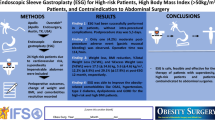Abstract
Purpose
Endoscopic sleeve gastroplasty (ESG) is primarily offered to patients with class I and II obesity (BMI 30–40), although there are no guidelines specifying applicability. There is little data comparing ESG to bariatric surgery in patients with class III obesity (BMI > 40). This study evaluates the short-term safety of ESG compared to sleeve gastrectomy (SG) and gastric bypass (RYGB) in patients with class III obesity.
Methods
We retrospectively analyzed over 500,000 patients who underwent ESG, SG, and RNYGB from 2016 to 2020 in the Metabolic and Bariatric Surgery Accreditation and Quality Improvement Program database. ESG patients were stratified by BMI to compare outcomes between class I and II versus class III obese patients. Class III obese patients who underwent ESG were also propensity matched to SG and RNYGB patients for matched comparisons. Primary outcomes included adverse events (AE), readmissions, re-operations, and re-interventions within 30 days. Secondary outcomes included procedure time, length of stay (LOS), and total body weight loss (%TBWL) at 30 days.
Results
Among ESG patients, those with BMI > 40 had no difference in AE, readmissions, or re-interventions versus patients with BMI 30–40 (p > 0.05), while achieving greater %TBWL at 30 days (p < 0.05). In comparison to surgery, ESG had similar AE to SG and less than RNYGB, while producing comparable %TBWL to SG and RNYGB at 30 days.
Conclusions
The feasibility and safety of ESG in patients with class III obesity are comparable to patients with class I and II obesity. Additionally, the safety of ESG in patients with class III obesity is comparable to SG and safer than RYGB.
Graphical Abstract
Endoscopic sleeve gastroplasty: a safe bariatric intervention for class III obesity (BMI > 40)

Similar content being viewed by others
Data Availability
All data, analytic methods, and study materials are available to other researchers upon request of the Metabolic and Bariatric Surgery Association Quality Improvement Program.
Abbreviations
- AE:
-
Adverse events within 30 days postprocedure
- ESG:
-
Endoscopic sleeve gastroplasty
- MBSAQIP:
-
Metabolic and Bariatric Surgery Accreditation and Quality Improvement Program
- RYGB:
-
Roux-en-Y gastric bypass
- SG:
-
Sleeve gastrectomy
References
Mehta A, Sharaiha RZ. Bariatric and metabolic endoscopy: impact on obesity and related comorbidities. Ther Adv Gastrointest Endosc. 2021;9(14):26317745211019156. https://doi.org/10.1177/26317745211019156.
Apovian CM. Obesity: definition, comorbidities, causes, and burden. Am J Manag Care. 2016;22(7 Suppl):s176–85.
GBD 2015 Obesity Collaborators, Afshin A, Forouzanfar MH, et al. Health effects of overweight and obesity in 195 countries over 25 years. N Engl J Med. 2017;377(1):13–27. https://doi.org/10.1056/NEJMoa1614362.
Liu N, Funk LM. Bariatric surgery trends in the U.S.: 1% is the loneliest number. Ann Surg. 2020;271(2):210–211. https://doi.org/10.1097/SLA.0000000000003714.
American Society of Metabolic and Bariatric Surgery [Internet]. c2022 [cited 2022 Dec 5]. Available from: https://asmbs.org/resources/estimate-of-bariatric-surgery-numbers.
Butt M, Simmers J, Rogers AM, Chinchilli VM, Rigby A. Predictors of surgical intervention for those seeking bariatric surgery. Surg Obes Relat Dis. 2021;17(9):1558–65. https://doi.org/10.1016/j.soard.2021.06.003.
Lopez-Nava G, Laster J, Negi A, Fook-Chong S, Bautista-Castaño I, Asokkumar R. Endoscopic sleeve gastroplasty (ESG) for morbid obesity: how effective is it? Surg Endosc. 2022;36(1):352–60. https://doi.org/10.1007/s00464-021-08289-1.
Hedjoudje A, Abu Dayyeh BK, Cheskin LJ, Adam A, Neto MG, Badurdeen D, et al. Efficacy and safety of endoscopic sleeve gastroplasty: a systematic review and meta-analysis. Clin Gastroenterol Hepatol. 2020;18(5):1043-1053.e4. https://doi.org/10.1016/j.cgh.2019.08.022.
Metabolic and Bariatric Association Quality Improvement Program [Internet]. Gainesville (FL): American College of Surgeons. c2015–2022 – [cited 2022 Dec 5]. Available from: https://www.facs.org/quality-programs/accreditation-and-verification/metabolic-and-bariatric-surgery-accreditation-and-quality-improvement-program/.
Amirian H, Torquati A, Omotosho P. Racial disparity in 30-day outcomes of metabolic and bariatric surgery. Obes Surg. 2020;30(3):1011–20. https://doi.org/10.1007/s11695-019-04282-9.
Li R, Veltzke-Schlieker W, Adler A, Specht M, Eskander W, Ismail M, et al. Endoscopic sleeve gastroplasty (ESG) for high-risk patients, high body mass index (> 50 kg/m2) patients, and contraindication to abdominal surgery. Obes Surg. 2021;31(8):3400–9. https://doi.org/10.1007/s11695-021-05446-2.
Pontecorvi V, Bove V, Gallo C. OP45 short term outcomes of endoscopic sleeve gastroplasty in class III obese patients: a clinical, retrospective, single center study. Endoscopy. 2021;53:S21.
Fayad L, Adam A, Schweitzer M, Cheskin LJ, Ajayi T, Dunlap M, et al. Endoscopic sleeve gastroplasty versus laparoscopic sleeve gastrectomy: a case-matched study. Gastrointest Endosc. 2019;89(4):782–8. https://doi.org/10.1016/j.gie.2018.08.030.
Alqahtani AR, Elahmedi M, Aldarwish A, Abdurabu HY, Alqahtani S. Endoscopic gastroplasty versus laparoscopic sleeve gastrectomy: a noninferiority propensity score-matched comparative study. Gastrointest Endosc. 2022;96(1):44–50. https://doi.org/10.1016/j.gie.2022.02.050.
Author information
Authors and Affiliations
Ethics declarations
Conflict of Interest
Dr. Vanessa Shami is a consultant for Olympus Medical and Cook Medical. Other co-authors do not have any conflicts of interest to disclose.
Consent to Participate
Informed consent does not apply.
Additional information
Publisher's Note
Springer Nature remains neutral with regard to jurisdictional claims in published maps and institutional affiliations.
Keypoints
• This is one of the few studies evaluating ESG in class III obesity.
• Adverse events (AE) remained low after ESG, including patients with BMI > 40.
• ESG had similar AE to bariatric surgery (SG, RYGB) in class III obesity.
Supplementary Information
Below is the link to the electronic supplementary material.
Rights and permissions
Springer Nature or its licensor (e.g. a society or other partner) holds exclusive rights to this article under a publishing agreement with the author(s) or other rightsholder(s); author self-archiving of the accepted manuscript version of this article is solely governed by the terms of such publishing agreement and applicable law.
About this article
Cite this article
Gudur, A.R., Geng, C., Radlinski, M. et al. Endoscopic Sleeve Gastroplasty: A Safe Bariatric Intervention for Class III Obesity (BMI > 40). OBES SURG 33, 1133–1142 (2023). https://doi.org/10.1007/s11695-023-06475-9
Received:
Revised:
Accepted:
Published:
Issue Date:
DOI: https://doi.org/10.1007/s11695-023-06475-9




